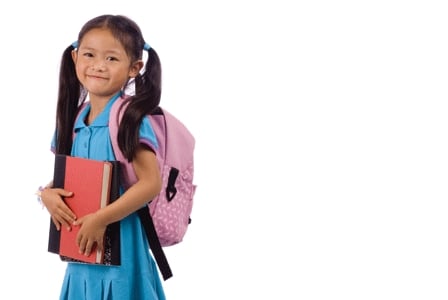
Kids these days can find themselves dealing with some weighty issues – backpack weight, that is. These days, heavy backpacks can cause kids pain or even injury.
Kids these days can find themselves dealing with some weighty issues—and we don’t mean those rising obesity rates in Canada’s youth. We’re talking about the weight children are carrying on their backs every day to and from school.
Backpacks are ubiquitous on the school scene and come in every shape, size, colour, and style—but some of them can cause kids pain or even injury, especially if backpacks are overloaded. Fortunately, this is a health problem that can be easily avoided if parents take some time to choose the right pack and teach their children how to wear it correctly.
Backpack facts
Research has shown that backpacks have an impact on back pain reported by kids. A large-scale study reported in the Journal of Pediatric Orthapaedics measured the weight and backpack load of 3,498 students, and found that back pain was highly prevalent, with the main predictor of pain being the weight of the backpack when compared with the student carrying it. Not too surprisingly, more weight meant greater reported pain.
| Maximum weight recommendations
According to the Canadian Chiropractic Association, backpacks should never exceed 15 percent of a person’s body weight. For children in elementary school, try to keep backpack weight below 10 percent of their body weight. Based on these recommendations:
|
As well, a smaller study reported in the journal Spine used magnetic resonance imaging to examine what happens to children’s spines when they are carrying backpacks of different weights. This study indicated that reported back pain from higher backpack loads may be due to reduced lumbar disc height and greater lumbar asymmetry (more curvature).
Signs of backpack strain
While research is still ongoing as to possible long-term effects of regular backpack use for kids, short-term effects of overloaded packs can include back, shoulder, and neck pain. Headaches and tingling hands may also be symptoms.
If your child seems unsteady or has trouble balancing while wearing his backpack, this is another sign that it is too heavy. Wrist, arm, or leg injuries can result from children falling down due to overloaded packs.
Pack lean
Books, binders, pencil cases, calculators, gym clothes, laptops, cell phones, lunches—kids these days have a lot of stuff to take to school. The Ontario Chiropractic Association has a long-running backpack health awareness program, called Pack it Light, Wear it Right.
They recommend that parents pack only what children really need for the day, pack heaviest objects closest to the body, and position oddly shaped items away from the back, toward the outside of the pack.
If your children are getting old enough to pack their own bags, monitor what goes in them to help keep toys and unnecessary trinkets out. Get your kids in the habit of cleaning out their backpacks weekly to prevent the accumulation of clutter.
Get the best fit
For a comfortable fit, make sure that your children wear both shoulder straps, one over each shoulder (many kids simply sling both straps over one shoulder, but this distributes weight unevenly).
Adjust the straps so that the pack fits snugly to the body without swinging to either side. You should be able to place your hand between your child’s back and the backpack—otherwise, it is on too tight. If there is a chest or waist strap, make sure to do this up as well, as it will lessen the load on the back.
Teach your children to bend their knees, hold the backpack in two hands, and use their leg muscles to lift the pack, then put on one shoulder strap at a time.
Remind them to take their backpacks off when they are standing for a long time, and to empty their backpacks into their lockers at school as soon as possible upon arriving.
By following these suggestions, you can ease the pain of going back to school for your kids by making sure that they are toting the right backpack—and wearing it properly.
How to pick a pack
Wondering what to look for in a pack, with the dizzying selection lining the store shelves, especially at back-to-school time? Here are some suggestions to help you find the right one.
Proportionate size
The top of the backpack should not be higher than the top of the shoulder, and the bottom of the backpack should not extend below the top of the hipbone. The pack should not be wider across than your child’s back.
Lightweight material
Nylon, canvas, and vinyl are recommended by the Canadian Chiropractic Association.
Padded shoulder straps
Straps should be at least two inches (5 cm) wide, easily adjustable, and not too snug around the arm and armpit area.
Padded back
This will make the backpack more comfortable. Some backpacks even have padded lumbar support options.
Several pockets
These will help to divide and distribute the weight of items in the pack and keep small items from shifting or being lost in the depths of one big pocket.
—Source: Canadian Chiropractic Association



























